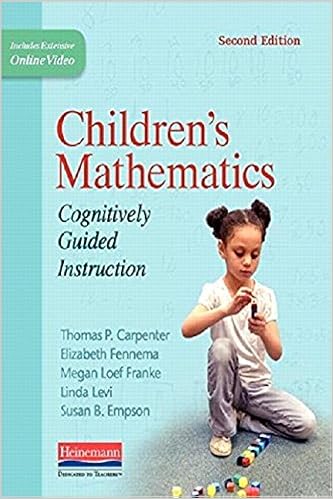|
Well, funny you should ask! This is the first of many posts that will introduce you to how I do CGI in my first grade classroom. My understanding of CGI is still evolving mind you, as I learn something new each time I teach a lesson, visit with a fellow teacher, or attend a workshop. And you will never believe, this understanding has grown from a great deal of skepticism that lodged itself in my math teaching philosophy not too many years ago.
I started CGI style math instruction about 5 years ago with my coteacher in our first grade inclusion classroom. Since that time, I have had 3 years of professional development here in Arkansas on CGI. A great deal of our training came from the book, Children's Mathematics, Cognitively Guided Instruction by Thomas P. Carpenter, Elizabeth Fennema, Megan Loef Franke, Linda Levi, and Susan B. Empson.  |
| click to find this book on amazon |
This is a great resource, I refer to it often when planning for instruction as well as evaluating student problem solving.
Over the past 5 years, I have learned so much about CGI and about the way our students naturally think about math and numbers. CGI is a way of teaching math that attempts to use a student's natural mathematics understanding to develop different math skills such as addition, subtraction, multiplication, and division. CGI helps students develop a strong number sense through exploration and problem solving before teaching standard algorithms.
Here's an example of how CGI might be used in older grades to teach a student to add two 2-digit numbers, you wouldn't teach them to write the problem vertically, add the ones and then the tens, and carry accordingly. Instead, you would present a word problem, such as Katie had 56 goldfish and Sarah had 28 goldfish. How many goldfish do they have all together. The teacher would then help students understand the problem, but not solve. Students would use any strategy that made sense to them to put the two number together, such as drawing a picture, using manipulatives, a number line, incrementing or any other strategy. As students work through these strategies, their understanding of place value and addition will grow. Later, they will grow into using more complex strategies such as the standard algorithm and more.
CGI style problem solving can be used to facilitate mastery of many objectives and is ideal for kindergarten through third grades. Can you imagine a kindergartner multiplying or dividing? Stick with me! I can't wait to tell you more.
This style of teaching is very student lead. There is very little teacher instruction, at least at the first part of class. As I mentioned before, I was very skeptical when I first began teaching CGI style math lessons. I thought that the problem solving approach was great for just that- problem solving, but more direct instruction was the only way for students to learn things like doubles and ten partners, fractions, place value, equal sign concepts and much more. I have been amazed time and time again at students of all levels who were able to reach a greater understanding of numbers and math concepts in all domains over the past few years. I probably don't have to tell you, I have been converted from a skeptic to a beliver!
CGI is not really new math, it has been out much longer than common core state standards, but it is new to many teachers. I know I had never heard of it before 5 years ago. CGI also lends itself so incredibly to CCSS objectives. I have taught almost every first grade math objective by incorporating CGI style lessons into my math units.
Are you wondering if CGI is for you and your students? I bet it might be! There is so much I can't wait to tell you about. We will talk about problem types, planning, student strategies, and many more things in the posts to come. The next post I do will be about setting up your classroom for CGI instruction. We will cover what I have found the most efficient way to store materials, work problems, display problems and more!
 |
